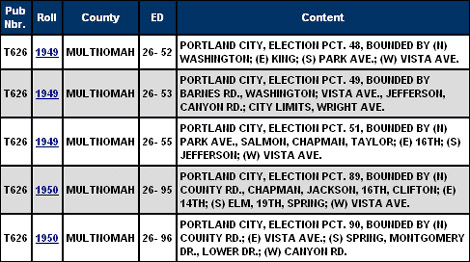
Search Strategies: Geographic
If the Census did not prepare a Soundex index for the state or territory you are looking for, you will see the state search page that includes:
- at the top, a geographic search graphic
- a search window for county name
- a search window for city name
- a search window for places or institutions
- a search window for enumeration district numbers
- search tips for each window
The geographic search identifies schedule roll(s) to view based on data you enter about the family's location in 1930. To most quickly identify which roll or rolls to consult, choose the search window for which you have the most specific, detailed geographic information. Please read the information below before proceeding.
Geographic Search
(available for all states and territories)
- Step 1: Find the ED number and roll number by searching a place name or an institution name.
- Step 2: View the microfilm roll for that ED, and locate the name.
Enumeration Districts
When the Bureau of the Census assigned areas for census takers to visit when collecting information from residents, it divided counties, cities, towns, villages, Indian reservations, and even hospitals and jails into enumeration districts (ED). Heavily populated areas like major cities would have dozens or even hundreds of EDs while rural counties and places would have only a few or one. Each county was assigned a number, and each ED within it was then numbered consecutively. When the census schedule sheets were compiled, they were arranged by state, county, city or township, and thereunder by ED number. They appear in this order on the microfilm.
The Bureau of the Census carefully recorded descriptions of each ED.
- In large cities, most descriptions included only the streets that bounded the district. Often the boundaries matched those of city wards or election precincts. ED descriptions did not include streets other than the boundary streets; i.e., interior streets were not listed.
- In rural areas the description might include geographic features like rivers or hills or the names of villages, post offices, or Indian reservations.
- Institutions such as hospitals, schools, jails, and orphan asylums were assigned enumeration districts.
The 1930 Census Microfilm Locator includes transcriptions of all ED boundaries. The complete original descriptions are also available as Microfilm publication number T1224, Descriptions of census Enumeration Districts, 1830 - 1950 (rolls 61 to 90 include the 1930 census). This microfilm publication is available at all NARA facilities nationwide.
The more specific information you have about where a person lived in 1930, especially in densely populated areas, the quicker you will be able to identify specific microfilm rolls. Since most urban EDs were described by the streets bounding them, it will help to know the exact street address. Finding the location on a contemporary map and then comparing it to the ED descriptions will allow you to identify which roll of schedule microfilm to consult.
The Bureau of the Census also used contemporary maps upon which it overlaid, often just with grease pencil notations, the boundaries and numbers of enumeration districts. The quality and visual clarity of the maps varied considerably. The complete set of these maps is available as National Archives Microfilm Publication M1930, Enumeration District Maps for the Fifteenth Census of the United States, 1930. This microfilm publication is available at all NARA facilities nationwide.
This search method allows for the display of all records in a county and to search for specific geographic places and features, such as streets, towns, villages, rivers, or institutions, such as hospitals, schools, jails, etc., by name.
Choose a county name from the drop-down list and press continue.
The next page, "City/County Search Results" will display the name of the state and county you have selected. It will show how many microfilm rolls cover that county and how many enumeration districts it had.
Displayed below will be links to each page of results for enumeration districts and institutions for the county. The results are paged to allow viewing the data in manageable lengths. Click on a page number to see the results in ED order.
When viewing a results table, click on the roll number for information about viewing the microfilm at a NARA facility and about buying or renting it.
To refine your search within the county, enter a search term in the lower window and press "Search Geographic Places."
Geographic Search Example
A search for a family that resided on Vista Avenue, in Portland, Multnomah County, Oregon, using the search term "Vista," returns the results below:
- "Vista" appears in each of the five records returned, as part of the boundary description of each ED.
- These EDs are contained on two rolls of microfilm, rolls 1949 and 1950.
- If the family lived on a street adjacent to one of the boundary streets, searching on their street name will not show up in the ED data.
- For an example, click on the ED map for this area. Myrtle, Laurel, and Chapman Streets do not show up as ED boundaries, but you can see on the map that they belong to the EDs listed here.
One can see from these results that one must be familiar with the local geography of Multnomah County in order to determine which of the five EDs listed might be the right one. Consulting the appropriate contemporary ED map (or even a current map) would assist the search.
What is your next step? Note the microfilm publication number and microfilm roll number of the roll(s) you wish to view. Then bring this microfilm information to a facility that has the census microfilm.
Choose this search method to search selected cities. The cities listed on the drop-down menu are those the Bureau of the Census listed separately from the counties. If the person you are searching resided within a listed city, check the city records instead of the county records.
Select the city name from the drop down menu, and press the continue button. The next page will be the "City/County Search Results" page. This page displays the name of the state and city selected. It also will show how many microfilm rolls cover that city and the number of database records that match it. Below this information will be search instructions and tips, along with the option to search geographic places or institutions.
This search method allows you to look for specific geographic places and features, such as streets, towns, villages, or rivers, or institutions such as hospitals, schools, or jails, by name across an entire state, or within county and city searches.
This method is helpful if you know that the person you are searching for lived in smaller town, village, or township, or in an institution as defined by the Bureau of the Census.
If you are searching for Spooner, Wisconsin but do not know the name of the county, enter the term "Spooner" into this window to yield the following results.
Clicking on the microfilm roll number shows that roll number 2616 covers the remainder of Washburn County and parts of Waukeesha County as well. Since the ED numbers for Spooner are given, however, you would have to check only two of the approximately 62 EDs on this microfilm roll.
What is your next step? Note the microfilm publication number and microfilm roll number of the roll(s) you wish to view. Then bring this microfilm information to a facility that has the census microfilm.
To determine which roll of microfilm covers a specific ED or EDs, use this method. This search is useful to researchers who have found an ED and wish to quickly find which roll of schedule microfilm to consult.
For example, a Soundex search for the Lamb family in Greene County, Alabama, pointed to a Soundex card that indicated the schedule record can be found under ED 32-1. Taking that information to the 1930 Census Microfilm Locator and entering it in the ED search window on the Alabama state search page yields the following result:
With this information a researcher can make arrangements to view or order the schedule microfilm roll number 18, and continue their search.
What is your next step? Note the microfilm publication number and microfilm roll number of the roll(s) you wish to view. Then bring this microfilm information to a facility that has the census microfilm.
Detailed geographic search tips. For additional search tips for locating EDs geographically, click here.




